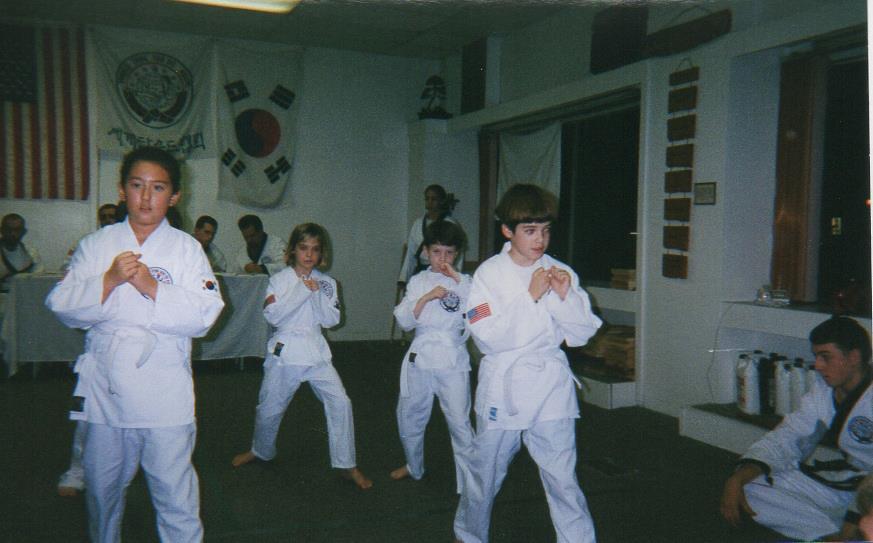Studio Information
Why Tang Soo Do?
The White Tiger in Water Logo
Studio Rules
- There are to be no Shoes worn in the Training Area (Dojang).
- Salute the Flags when entering and leaving Training Area (Dojang).
- Upon entering and leaving the school, bow to all Students and Instructors present.
- Arrive 15 Minutes early to stretch and practice techniques already learned.
- No Jewelry, no Smoking, and no Chewing Gum are allowed while class is in session.
- Students must keep the Training Area (Dojang) clean and organized.
- Answer Instructors: “Yes Sir/Ma’am” and “No Sir/Ma’am”.
- Say Thank You (Ko Map Sum Ni Da) and You’re Welcome (Chomanio).
- Martial Arts begins and ends with Respect.
- Salute the Flags when entering and leaving Training Area (Dojang).
- Upon entering and leaving the school, bow to all Students and Instructors present.
- Arrive 15 Minutes early to stretch and practice techniques already learned.
- No Jewelry, no Smoking, and no Chewing Gum are allowed while class is in session.
- Students must keep the Training Area (Dojang) clean and organized.
- Answer Instructors: “Yes Sir/Ma’am” and “No Sir/Ma’am”.
- Say Thank You (Ko Map Sum Ni Da) and You’re Welcome (Chomanio).
- Martial Arts begins and ends with Respect.
Promotion Requirements
Promotion is an important part of each student’s journey. Testing cycles occur monthly. The Instructor will advise the student when testing for the next belt will occur. When the minimum time has passed, the student will be evaluated and the instructors will make a determination. Many factors are reviewed including but not limited to:
When the Instructor (Sah Bum Nim) has determined that a student is ready to move to the next phase of training, the student will receive an Invitation explaining in detail what steps must be taken. Each student is required to pass both a Written Test and a Physical Test based on guidelines listed in the student handbook. Testing is a multi-step process: The student must complete and return the following documents: Testing Application Form(s), Testing Fee(s), Student’s Membership Card, and, for certain ranks, a Thesis Essay.
Next, the student will need to take the Written Test. Each student is given three (3) dates on which the test can be taken, and it is the student’s responsibility to arrive and take the exam in Uniform. A student only gets once chance to pass the test per cycle. Each student must pass the Written Test before continuing on to the Physical Test. Then there is the Physical Test where the student must efficiently perform a demonstration of skills of all the required techniques for their rank. After all of the paperwork is completed and the grades are determined, a passing student will receive their new belt at the end of class one night during the weeks following the test.
Parents and family members are strongly encouraged to attend tests, promotions, tournaments, and other special Tang Soo Do events. These special events make wonderful opportunities to photograph or videotape the students “in action”.
- General Knowledge
- Terminology
- Anatomy
- History & Philosophy
- Attitude, Concentration, Effort, Spirit, Conduct, & Etiquette
- Basic Techniques: Stances, Blocks, Kicks, Punches, Strikes, & Combinations
- Forms: Patterns of Moving Techniques
- One Step Sparring & Counter Attacks
- Self Defense, Rolls, & Break Falls
- Free Sparring & Street Defense
- Physical Fitness: Flexibility & Endurance
- Breaking Ability
When the Instructor (Sah Bum Nim) has determined that a student is ready to move to the next phase of training, the student will receive an Invitation explaining in detail what steps must be taken. Each student is required to pass both a Written Test and a Physical Test based on guidelines listed in the student handbook. Testing is a multi-step process: The student must complete and return the following documents: Testing Application Form(s), Testing Fee(s), Student’s Membership Card, and, for certain ranks, a Thesis Essay.
Next, the student will need to take the Written Test. Each student is given three (3) dates on which the test can be taken, and it is the student’s responsibility to arrive and take the exam in Uniform. A student only gets once chance to pass the test per cycle. Each student must pass the Written Test before continuing on to the Physical Test. Then there is the Physical Test where the student must efficiently perform a demonstration of skills of all the required techniques for their rank. After all of the paperwork is completed and the grades are determined, a passing student will receive their new belt at the end of class one night during the weeks following the test.
Parents and family members are strongly encouraged to attend tests, promotions, tournaments, and other special Tang Soo Do events. These special events make wonderful opportunities to photograph or videotape the students “in action”.
Competitions & Tournaments
The techniques and forms found in Tang Soo Do are designed to improve the student’s ability to defend oneself. The more a student practices outside of class, the sooner techniques improve and the better one can be able to defend oneself should the need arise. Practice also magnifies the other benefits of training such as improved fitness, flexibility, concentration, and discipline. For these reasons, natural athletic ability is not a substitute for diligent practice, especially as a student progresses into higher ranks. Ultimately, a student’s training is one’s own responsibility and dedication will determine the speed and level of progress. Like any other worthwhile endeavor, the more a student puts into Tang Soo Do training, the more he or she will get out of it.
While Tang Soo Do is considered an art as opposed to a sport, there are a number of Regional Tournaments and Clinics scheduled that provide competition and specialized training for those who have the desire to compete or learn additional skills. There are seasonal, yearly, and biannual events that you will hear about from time to time. Some of the benefits of competition include meeting students from other schools — and even other countries, — increased confidence, the chance to compare techniques with other students, and the opportunity to learn from others. Tournaments are always educational and fun to watch, even for those not competing.
Tournaments are arranged so that students of similar age, gender, and rank compete with each other. Events include Forms (Hyung), Sparring (Dae Ryun), Weapons (Moo Ki), and sometimes Breaking (Kyuck Pa) and Creativity. Students may compete in any number of categories depending on their belt level. Instructors will prepare the students for upcoming competitive events and there will be special classes so that students know all the rules, policies, and procedures for tournaments.
While Tang Soo Do is considered an art as opposed to a sport, there are a number of Regional Tournaments and Clinics scheduled that provide competition and specialized training for those who have the desire to compete or learn additional skills. There are seasonal, yearly, and biannual events that you will hear about from time to time. Some of the benefits of competition include meeting students from other schools — and even other countries, — increased confidence, the chance to compare techniques with other students, and the opportunity to learn from others. Tournaments are always educational and fun to watch, even for those not competing.
Tournaments are arranged so that students of similar age, gender, and rank compete with each other. Events include Forms (Hyung), Sparring (Dae Ryun), Weapons (Moo Ki), and sometimes Breaking (Kyuck Pa) and Creativity. Students may compete in any number of categories depending on their belt level. Instructors will prepare the students for upcoming competitive events and there will be special classes so that students know all the rules, policies, and procedures for tournaments.













